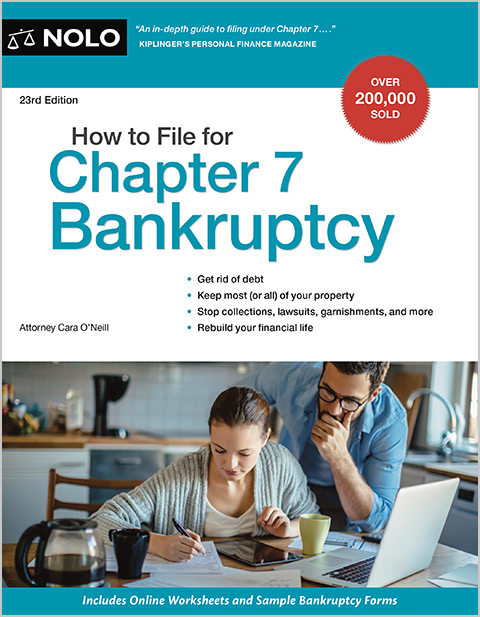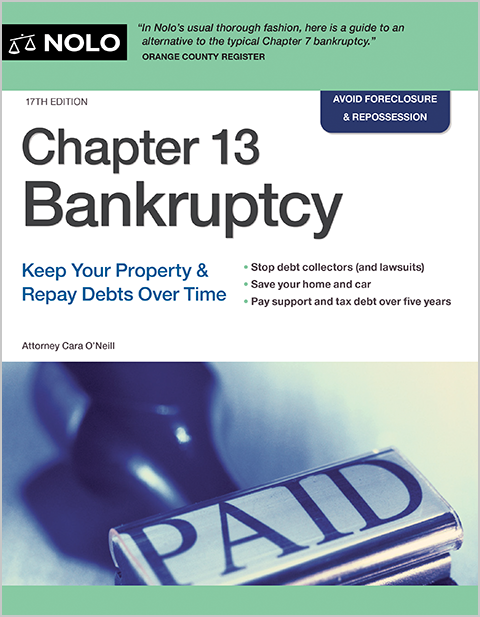Chapter 7 bankruptcy erases many debts, such as credit card and medical bills, within four months, but some obligations, such as student loans and child support, remain.
Before filing for bankruptcy, you'll want to know which debts are forgiven in a bankruptcy action. For instance, Chapter 7 bankruptcy "discharges" credit card balances, medical bills, past-due rent payments, payday loans, overdue cellphone and utility bills, car loan balances, and even home mortgages in as little as four months.
However, not all obligations go away in Chapter 7. In this article, you'll learn how Chapter 7 bankruptcy clears debt, which debts Chapter 7 will discharge, why your filing date determines what bankruptcy covers, which debts and liens Chapter 7 bankruptcy won't clear, and how to stop collection calls after bankruptcy.
- Does Bankruptcy Clear All Debt?
- How Much Debt to File Chapter 7 Bankruptcy
- How Does a Chapter 7 Bankruptcy Discharge Work?
- What Chapter 7 Discharges
- Nondischargeable Debts in Chapter 7
- Secured Debts and Liens
- Filing Date Controls What's Discharged
- Chapter 7 vs. Chapter 13 Discharge
- After Filing: Stopping Collections and Credit Calls
- Need More Help?
Does Bankruptcy Clear All Debt?
No. Although bankruptcy erases many types of debt, not all obligations are discharged. Also, debts are treated differently depending on which of the three types of bankruptcy you file. Before filing, knowing which bankruptcy chapter you'll file under to resolve your particular debt problem is essential.
How Much Debt to File Chapter 7 Bankruptcy
Bankruptcy filers aren't required to have a minimum debt amount before filing for Chapter 7 bankruptcy, and multiple bankruptcy filings are allowed. However, a Chapter 7 discharge is available only every eight years, so most people don't file unless they can erase a substantial amount and don't have reason to believe they'll incur more. (11 U.S.C. § 727(a)(8).)
How Does a Chapter 7 Bankruptcy Discharge Work?
A bankruptcy discharge is an order issued by the bankruptcy court that discharges the bankruptcy filer from a contract with a creditor. Without the contract, the filer isn't legally required to pay the discharged debt, and the creditor can't take collection actions.
Most Chapter 7 filers receive a discharge order about four months after filing the bankruptcy petition. The bankruptcy filer's credit report will show the debt "discharged in Chapter 7 bankruptcy" for up to ten years (and up to seven years after Chapter 13). However, the notation's impact on the debtor's credit score will lessen over time.
What Chapter 7 Discharges
Chapter 7 filers discharge all of the following debts (Chapter 13 discharge erases a few more):
- credit card charges, including overdue and late fees
- collection agency accounts
- medical bills
- personal loans from friends, family, and employers
- past-due utility balances
- repossession deficiency balances
- most auto accident claims
- business debts
- past-due rent and money owed under lease agreements
- most civil court judgments
- old tax penalties and unpaid taxes
- most attorneys' fees
- government program overpayments, including welfare, Social Security, and veterans' assistance programs.
As much as we'd like to, we can't create a list of all dischargeable debts because bankruptcy law doesn't tell us every debt you can discharge. Instead, it tells us the debts you can't erase in bankruptcy (more below). Because you might have dischargeable debts that don't appear above, it's best to review your specific debts with a bankruptcy lawyer.
Note about fraud and utility deposits. Any debt-related fraud can turn a dischargeable obligation into a nondischargeable debt if the creditor wins a lawsuit alleging fraud. Also, a utility provider can't refuse service because of a bankruptcy filing, but can charge a reasonable deposit to ensure future payment. Find out about utility shut-offs and Chapter 7 bankruptcy.
Nondischargeable Debts in Chapter 7
The discharge order won't list the debts you wiped out in Chapter 7. Instead, it will list the debts that bankruptcy law says all filers must continue to pay. You'll stay on the hook for the following.
Domestic Support and Recent Taxes (Priority Debt)
You must repay important priority debts even if you file for bankruptcy. (11 U.S.C. § 507(a).) For instance, you can't discharge support obligations, such as child and spousal support. Also, many tax debts are nondischargeable, except for certain older income taxes and tax penalties when strict timing and filing rules are met.
Fraud, Willful Injury, and DUI Injury Debts
A court can declare an obligation nondischargeable if a filer defrauded the creditor or engaged in another wrongful action, such as injuring or killing someone while driving under the influence. (11 U.S.C. § 523(a)(2), (6), (9).) The creditor must first file a bankruptcy lawsuit (an adversary proceeding) and prove that the debtor committed fraud or a qualifying wrongful act.
Student Loans
The bankruptcy court doesn't automatically discharge student loans. You'll remain responsible for paying a student loan after Chapter 7 bankruptcy unless you file an adversary proceeding and prove that repaying the debt would cause you undue hardship or meet a similar burden required by your bankruptcy court. (11 U.S.C. § 523(a)(8).)
Even though these debts aren't discharged in Chapter 13, most emerge from Chapter 13 utterly debt-free, except for home and student loans. Why? Because the filer must pay off most nondischargeable debts through the payment plan.
Secured Debts and Liens
Chapter 7 eliminates your personal obligation on mortgages, car loans, and other secured debts, but liens typically survive. If you stop paying, the lender can repossess or foreclose on the property under its lien rights unless you reaffirm or otherwise resolve the obligation. Therefore, you can wipe out mortgages, car loans, and other secured debts. But if you don't continue to pay as agreed, the lender will likely take back the home, car, or other collateral through its lien rights (although some exceptions apply). (11 U.S.C. § 506(d).)
You must also meet other requirements to avoid losing property in Chapter 7, so consider learning about keeping a home and keeping a car in bankruptcy.
Bankruptcy automatically clears you of the responsibility to pay a mortgage, car loan, or secured debt. However, bankruptcy doesn't remove a voluntary lien, which is freely given as part of financing and allows the creditor to take property if you don't pay. So, bankruptcy will automatically erase the payment contract, but not the agreement to return the property if you violate it.
That's why you'll lose your car if you don't continue paying your car payment informally or sign a reaffirmation agreement. The lender can use its lien rights to repossess it during Chapter 7 after successfully asking the court to lift the "automatic stay" order, or wait until the Chapter 7 case ends.
Filing Date Controls What's Discharged
Your Chapter 7 bankruptcy will discharge debts you had before filing, but not debts you incurred after filing, even if they were incurred before you received your discharge. Here's how it works.
- Pre-filing debt. The bankruptcy court will discharge all qualifying "pre-petition" debt. You incur pre-petition debts before you file for bankruptcy.
- Post-filing debt. The bills you rack up after filing for Chapter 7 are considered "post-petition" debts. You'll remain responsible for paying post-petition balances, including those incurred during your bankruptcy case.
In short, the bankruptcy court discharges debts that existed before the Chapter 7 filing date. You'll have to pay for anything you get on credit after filing your petition, even bills you incur before receiving a discharge.
Example. Jessica fell behind on her electric bill, listed the balance on her Chapter 7 bankruptcy schedules, and continued using her electric service. After receiving her Chapter 7 discharge, the energy company deleted the charges predating her bankruptcy filing and billed her for the electricity she used after her bankruptcy filing date.
Chapter 7 vs. Chapter 13 Discharge
Most people opt for Chapter 7 bankruptcy when available because it works the fastest, usually taking about four months to complete. It wipes out qualifying debts but doesn't help you with other issues, such as saving a home from foreclosure, a car from repossession, or paying nondischargeable debts over time.
If you need help saving a home or car or would like time to pay off a domestic support obligation, taxes, or another nondischargeable debt over time, Chapter 13's payment plan can help. Chapter 13 also discharges more debts than Chapter 7, including debts resulting from a marital property division and tax debt charged on a credit card. Many people choose this chapter when they need the help available in Chapter 13, but you might also need to file if you earn too much to qualify for Chapter 7.
Chapter 11 is a more complicated chapter used by businesses struggling to stay open and individuals with too much debt to qualify for Chapter 13.
After Filing: Stopping Collections and Credit Calls
You can stop most creditor calls by providing your bankruptcy case number and filing date. Start by finding a filed bankruptcy document or notice. You should have one handy because you get copies of all mailings, even if a bankruptcy lawyer represents you. The filing date will be next to the case number at the top.
Why will this work? The creditor can use the information to verify your bankruptcy, and if the calls don't stop, the creditor will face sanctions.
Need More Help?
Did you know Nolo has made the law accessible for over fifty years? It's true, and we wholeheartedly encourage research and learning. However, online articles and resources can't address all bankruptcy issues and aren't written with the facts of your particular case in mind. The best way to protect your assets in bankruptcy is by hiring a local bankruptcy lawyer.
|
|
- Does Bankruptcy Clear All Debt?
- How Much Debt to File Chapter 7 Bankruptcy
- How Does a Chapter 7 Bankruptcy Discharge Work?
- What Chapter 7 Discharges
- Nondischargeable Debts in Chapter 7
- Secured Debts and Liens
- Filing Date Controls What's Discharged
- Chapter 7 vs. Chapter 13 Discharge
- After Filing: Stopping Collections and Credit Calls
- Need More Help?

